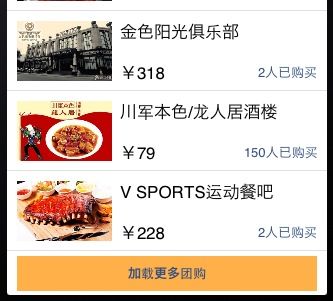使用xib文件创建UITableViewCell
现在我们看一下最终效果: 上部:
底部:
如上图中,可以使用表格UITableView, 顶部的图片轮换可以采用scrollView,加上一个定时器。中间部分,因为每一个cell的中子控件位置固定,大小固定。底部有一个加载更多的按钮。所以,我们可以对顶部图片轮换,中间固定部分,底部,加载更多部分,都使用xib文件 。顶部作为表格的头部,中间作为表格的每一个cell ,底部加载更多作为表格的底部部分。
一:代码结构如图:
代码部分解析:
1:第一部分是控制器
2,第二部分是cell的view类和xib文件,cell模型类继承自UITableViewCell .
3, 第三部分是 尾部的view类和xib
4,第四部分是头部的view类和xib
5, 第五部分是模型对象
二:代码部分:
1,ViewController.m文件:
#import "MJViewController.h"
#import "MJTg.h"
#import "MJTgCell.h"
#import "MJTgFooterView.h"
#import "MJTgHeaderView.h"
@interface MJViewController () <UITableViewDataSource,MJTgFooterViewDelegate>
@property (weak, nonatomic) IBOutlet UITableView *tableView;
@property(nonatomic,strong) NSMutableArray *tgs;
@end
@implementation MJViewController
- (void)viewDidLoad
{
[super viewDidLoad];
//设置每一行的高度
self.tableView.rowHeight = 80;
MJTgFooterView *footerView = [MJTgFooterView tgFooterView];
footerView.delegate =self;
self.tableView.tableFooterView = footerView;
self.tableView.tableHeaderView = [MJTgHeaderView tgHeaderView];
}
#pragma mark - MJTgFooterViewDelegate的代理方法
/** 加载按钮的更多数据 */
-(void)tgFooterViewDidLoadBtnClick:(MJTgFooterView *)tgfooterView{
//加载更多的模型数据
int count = self.tgs.count;
NSArray *array = self.tgs;
for (int i=0; i MJTg *tg = array[i]; MJTg *tempTg = [[MJTg alloc] init]; tempTg.title = tg.title; tempTg.icon =tg.icon; tempTg.price = tg.price; tempTg.buyCount = tg.buyCount; [self.tgs addObject:tempTg]; } //2,刷新表格,高数tableView重新加载模型数据,调用tableView的reloadData方法 [self.tableView reloadData]; } -(NSMutableArray *)tgs{ if(_tgs == nil){ // 初始化 // 1. 获得plist的全路径 NSString *path = [[NSBundle mainBundle] pathForResource:@"tgs.plist" ofType:nil]; //2,健在数组 NSArray *dictArray = [NSArray arrayWithContentsOfFile:path]; //3,将dictArray里面的所有字典都转换成模型对象,放到新的数组中 NSMutableArray *tgArray = [NSMutableArray array]; for (NSDictionary *dict in dictArray) { // 3.1 创建模型对象 MJTg *tg=[MJTg tgWithDict:dict]; // 3.2 添加模型对象到数组中 [tgArray addObject:tg]; } //4,赋值 _tgs = tgArray; } return _tgs; } #pragma mark - 数据源方法 /** 一共有多少行数据 */ -(NSInteger)tableView:(UITableView *)tableView numberOfRowsInSection:(NSInteger)section{ return self.tgs.count; } /** 每一行显示怎么样的cell */ -(UITableViewCell *)tableView:(UITableView *)tableView cellForRowAtIndexPath:(NSIndexPath *)indexPath{ MJTgCell *cell =[MJTgCell cellWithTableView:tableView]; MJTg *tg = self.tgs[indexPath.row]; cell.tg =tg; return cell; } @end 2,TgCell的xib文件和TgCell.h对应的部分,如图: #import @class MJTg; @interface MJTgCell : UITableViewCell @property (weak, nonatomic) IBOutlet UIImageView *iconView; @property (weak, nonatomic) IBOutlet UILabel *titleLbl; @property (weak, nonatomic) IBOutlet UILabel *priceLbl; @property (weak, nonatomic) IBOutlet UILabel *buyCountLbl; /** 团购模型 */ @property(nonatomic,strong) MJTg *tg; /** 通过一个tableView来创建一个cell */ +(id)cellWithTableView:(UITableView *)tableView; @end TgCell.m文件如下: #import "MJTgCell.h" #import "MJTg.h" @implementation MJTgCell +(id)cellWithTableView:(UITableView *)tableView{ static NSString *flag= @"tgs"; MJTgCell *cell = [tableView dequeueReusableCellWithIdentifier:flag]; if(cell ==nil){ cell = [[NSBundle mainBundle] loadNibNamed:@"MJTgCell" owner:nil options:nil][0]; } return cell; } -(void)setTg:(MJTg *)tg{ self.iconView.image = [UIImage imageNamed:tg.icon]; self.titleLbl.text = tg.title; self.priceLbl.text = [NSString stringWithFormat:@"¥%@",tg.price]; self.buyCountLbl.text = [NSString stringWithFormat:@"%@人已购买",tg.buyCount]; } @end 3,TgFooterView的xib文件和TgFooterView.h对象如下: 这儿需要注意一点:当点击加载更多按钮之后,将刷新按钮和正在拼命加载显示出来。所以,一开始的时候,将view隐藏,当点击按钮之后,再将按钮隐藏,view显示出来。 TgFooterView.h代码如下:
#import @class MJTgFooterView; @protocol MJTgFooterViewDelegate <NSObject> @optional -(void)tgFooterViewDidLoadBtnClick:(MJTgFooterView *)tgfooterView; @end @interface MJTgFooterView : UIView @property(nonatomic,weak) id<MJTgFooterViewDelegate> delegate; +(id)tgFooterView; @end TgFooterView.m文件代码:
#import "MJTgFooterView.h" @interface MJTgFooterView () @property (weak, nonatomic) IBOutlet UIButton *loadBtn; @property (weak, nonatomic) IBOutlet UIView *loadingView; - (IBAction)loadBtnClick; @end @implementation MJTgFooterView +(id)tgFooterView{ //创建Nib对象 // UINib *nib = [UINib nibWithNibName:@"MJTgFooterView" bundle:[NSBundle mainBundle]]; // return [[nib instantiateWithOwner:nil options:nil] lastObject]; return [[NSBundle mainBundle] loadNibNamed:@"MJTgFooterView" owner:nil options:nil][0]; } - (IBAction)loadBtnClick { //1,将加载按钮隐藏 self.loadBtn.hidden = YES; //2,刷新按钮显示出来 self.loadingView.hidden = NO; //3.0秒之后执行block中 dispatch_time_t popTime = dispatch_time(DISPATCH_TIME_NOW, (int64_t)(2.0 * NSEC_PER_SEC)); dispatch_after(popTime, dispatch_get_main_queue(), ^(void){ //3,通知代理,按钮被人点击了 if([self.delegate respondsToSelector:@selector(tgFooterViewDidLoadBtnClick:)]){ [self.delegate tgFooterViewDidLoadBtnClick:self]; } //4,加载按钮显示,刷新按钮隐藏 self.loadBtn.hidden = NO; self.loadingView.hidden = YES; }); } @end 3,TgHeaderView的xib和TgHeaderView属性对应部分: TgHeaderView.h文件的代码:
#import @interface MJTgHeaderView : UIView +(id)tgHeaderView; @end TgHeaderView.m文件代码:
#import "MJTgHeaderView.h" #define MJImgCount 5 @interface MJTgHeaderView () <UIScrollViewDelegate> @property (weak, nonatomic) IBOutlet UIScrollView *scrollView; @property (weak, nonatomic) IBOutlet UIPageControl *pageControl; @property(nonatomic,strong) NSTimer *timer; @end @implementation MJTgHeaderView +(id)tgHeaderView{ return [[[NSBundle mainBundle] loadNibNamed:@"MJTgHeaderView" owner:nil options:nil] lastObject]; } /** 当xib文件唤醒之后调用(就是xib文件上的空间加载完之后就会调用这个方法) */ -(void)awakeFromNib{ //1,设置scrollView的代理 self.scrollView.delegate = self; //2,设置scrollView中的image中的参数 CGFloat imgViewY = 0; CGFloat imgViewW = self.scrollView.frame.size.width; CGFloat imgViewH = self.scrollView.frame.size.height; for (int i=0; i<MJImgCount; i++) { UIImageView *imgView = [[UIImageView alloc] init]; UIImage *img = [UIImage imageNamed:[NSString stringWithFormat:@"ad_0%i",i]]; imgView.image = img; CGFloat imgViewX = i*imgViewW; imgView.frame = CGRectMake(imgViewX, imgViewY, imgViewW, imgViewH); //3,将image添加到scrollView中 [self.scrollView addSubview:imgView]; } //4,设置scrollView的各项参数 //4.1,设置scrollView的滚动区域 self.scrollView.contentSize = CGSizeMake(imgViewW * MJImgCount, 0); //4.2, 不显示横向滚动条 self.scrollView.showsHorizontalScrollIndicator = NO; //4.3 分页 self.scrollView.pagingEnabled = YES; //5,设置pageControl的总共页数 self.pageControl.numberOfPages = MJImgCount; //6,添加定时器 [self addTimer]; } /** 添加定时器 */ -(void)addTimer{ self.timer = [NSTimer timerWithTimeInterval:2.0 target:self selector:@selector(nextImg) userInfo:nil repeats:YES]; //消息循环(设置当前定时器的优先级比较) [[NSRunLoop currentRunLoop] addTimer:self.timer forMode:NSRunLoopCommonModes]; } -(void)nextImg{ //1,增加pageControl的页码 int currentIndex = self.pageControl.currentPage; if(currentIndex == MJImgCount-1){ currentIndex = 0; }else{ currentIndex += 1; } self.pageControl.currentPage = currentIndex; //2,计算scrollView的滚动位置 CGPoint offset = CGPointMake(currentIndex * self.scrollView.frame.size.width, 0); //3,有滚动效果 [self.scrollView setContentOffset:offset animated:YES]; } #pragma mark - scrollView的代理方法 /** scrollView正在滚动 */ -(void)scrollViewDidScroll:(UIScrollView *)scrollView{ CGFloat offsetX = scrollView.contentOffset.x; int index = (offsetX + scrollView.frame.size.width*0.5)/scrollView.frame.size.width; self.pageControl.currentPage = index; } 4,Tg模型部分: Tg.h文件:
#import @interface MJTg : NSObject /** 标题 */ @property(nonatomic,copy) NSString *title; /** 图标 */ @property(nonatomic,copy) NSString *icon; /** 价格 */ @property(nonatomic,copy) NSString *price; /** 购买人数 */ @property(nonatomic,copy) NSString *buyCount; +(id)tgWithDict:(NSDictionary *)dict; -(id)initWithDict:(NSDictionary *)dict; @end Tg.m文件代码如下:
#import "MJTg.h" @implementation MJTg +(id)tgWithDict:(NSDictionary *)dict{ return [[self alloc] initWithDict:dict]; } -(id)initWithDict:(NSDictionary *)dict{ if(self==[super init]){ [self setValuesForKeysWithDictionary:dict]; } return self; } @end 注意部分: 1,在TgCell.xib文件中,指定类为TgCell。 2,在创建TgCell对象时,要采用Cell的重用。 重用原理:在tableView滚动时,部分UITableViewCell会移出窗口,UITableView会将窗口外的UITableViewCell放入到一个对象池中,等待着重用,当UITableView要求datasource返回UITableViewCell时,datasource会先查看这个对象池,如果池中有未使用的UITableViewCell,datasource会使用新的数据配置这个UITableViewCell,然后返回给UITableView,重新显示到窗口中,从而避免创建新对象。 代码如下: +(id)cellWithTableView:(UITableView *)tableView{ static NSString *flag= @"tgs"; MJTgCell *cell = [tableView dequeueReusableCellWithIdentifier:flag]; if(cell ==nil){ cell = [[NSBundle mainBundle] loadNibNamed:@"MJTgCell" owner:nil options:nil][0]; } return cell; } >1,新建一个xib文件描述一个view的内部结构(假设叫做TgCell.xib) >2, 新建一个自定义类(自定义类需要继承自系统自带的view,继承自哪个类,取决于xib根对象的class) >3, 新建的雷鸣最好跟xib文件名保持一致(比如类名就叫做TgCell) >4, 将xib中的空间和自定义类的.m文件进行连线 >5, 提供一个类方法返回一个创建好的自定义view(屏蔽从xib加载的过程) >6, 提供一个模型属性让外界传递模型数据 >7, 重写模型属性的setter方法,在这里将模型数据展示到对应的子控件上面






